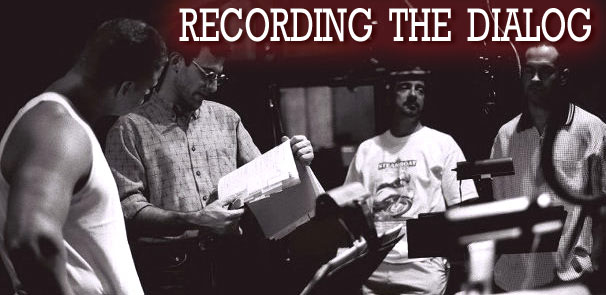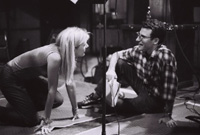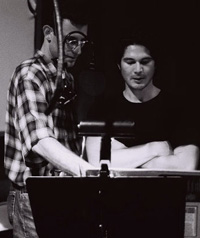|

All of the actors' dialog was
recorded over a period of about a week, initially intended
to be an easy schedule this, like many other aspects of
Son of a Wanted Man, quickly turned into a war against technical
glitches, rescheduling, lost catering, and trying to organize
the many actors into and out of the studio in the right
order.
|
For
Techno Geeks:
Here's a rundown
of the studio, mics, speakers and other recording
equipment we used to record
Son of a Wanted Man.
CLICK HERE
|
Unlike some who feel that
"radio" acting is the process of creating an entire
character (in my opinion caricature) with your voice, I
just try to approach it as simple drama but played in a
very intimate manner. Voice Over work is like a “big close
up” in film; when you can hear a persons tongue move in
their mouth or the hiss of breath in their nostrils you
find that you are practically inside the performer.
Overacting when the microphone is just inches away is very
easy.
 Getting
a good recording relies on proximity to the microphone but
often getting a good performance requires using your body
in addition to your mouth. I'm always torn about how much
to let the actors move when they are on mic. Some movement
fits the scene; there were cases when characters were walking
where we put the mic on a boom (pole) and followed them
around the studio. When Mike is supposed to pull himself
out of the pit beneath the steam engine, the mic followed
him as he got up off the floor. When he and Drucilla made
their way across the wire bridge, I made them stand on the
narrow edge of a two-by-four. Anything that involves the
body seems to improve the performance; we used many props
like saddles and hats, and sometimes George, playing Mike,
would just jump up and down between takes. Getting
a good recording relies on proximity to the microphone but
often getting a good performance requires using your body
in addition to your mouth. I'm always torn about how much
to let the actors move when they are on mic. Some movement
fits the scene; there were cases when characters were walking
where we put the mic on a boom (pole) and followed them
around the studio. When Mike is supposed to pull himself
out of the pit beneath the steam engine, the mic followed
him as he got up off the floor. When he and Drucilla made
their way across the wire bridge, I made them stand on the
narrow edge of a two-by-four. Anything that involves the
body seems to improve the performance; we used many props
like saddles and hats, and sometimes George, playing Mike,
would just jump up and down between takes.
 Although
there were no studio executives giving us conflicting goals
as is often the case in film, (since we self financed Son
of a Wanted Man, Paul and I are essentially "the studio")
… I still can't really say that what ended up on tape is
"my vision." Every project creates itself. Each
has a separate personality and you are never really in control
of what it becomes … It's more of a process of shepherding
it in the right direction and allowing it to mature in a
positive way rather than saying 'I am in control and the
result will be like this.' We made the best of many situations
and often the adjustments we had to make created something
much more interesting than we had originally had in mind.
As a writer you realize that once you get some of a scene
on paper it will start telling you where it wants to go;
as a director you hear the actors rehearse it and you learn
what you are going to have to work with, you get them in
the studio and try to keep them all headed in the right
direction and keep the sudden pressure to perform from getting
the better of them. Although
there were no studio executives giving us conflicting goals
as is often the case in film, (since we self financed Son
of a Wanted Man, Paul and I are essentially "the studio")
… I still can't really say that what ended up on tape is
"my vision." Every project creates itself. Each
has a separate personality and you are never really in control
of what it becomes … It's more of a process of shepherding
it in the right direction and allowing it to mature in a
positive way rather than saying 'I am in control and the
result will be like this.' We made the best of many situations
and often the adjustments we had to make created something
much more interesting than we had originally had in mind.
As a writer you realize that once you get some of a scene
on paper it will start telling you where it wants to go;
as a director you hear the actors rehearse it and you learn
what you are going to have to work with, you get them in
the studio and try to keep them all headed in the right
direction and keep the sudden pressure to perform from getting
the better of them.
When you cut it together you can
only make the best of what you have but, strangely, much
of the time you find something coming together that is distinctly
different from what you expected.
In the end, the project is the
average of all it’s parts; all of the people, all the decisions,
that went into it. You "direct" it by nudging
these parts and decisions in the best direction that you
can get them to go in and then adjusting to the result later.
It’s not true that trying to force
a predetermined result is difficult … it’s impossible.
Once we had the actors down on
hard disk, we had to create their world. This meant SOUND
EFFECTS and MUSIC.
|
